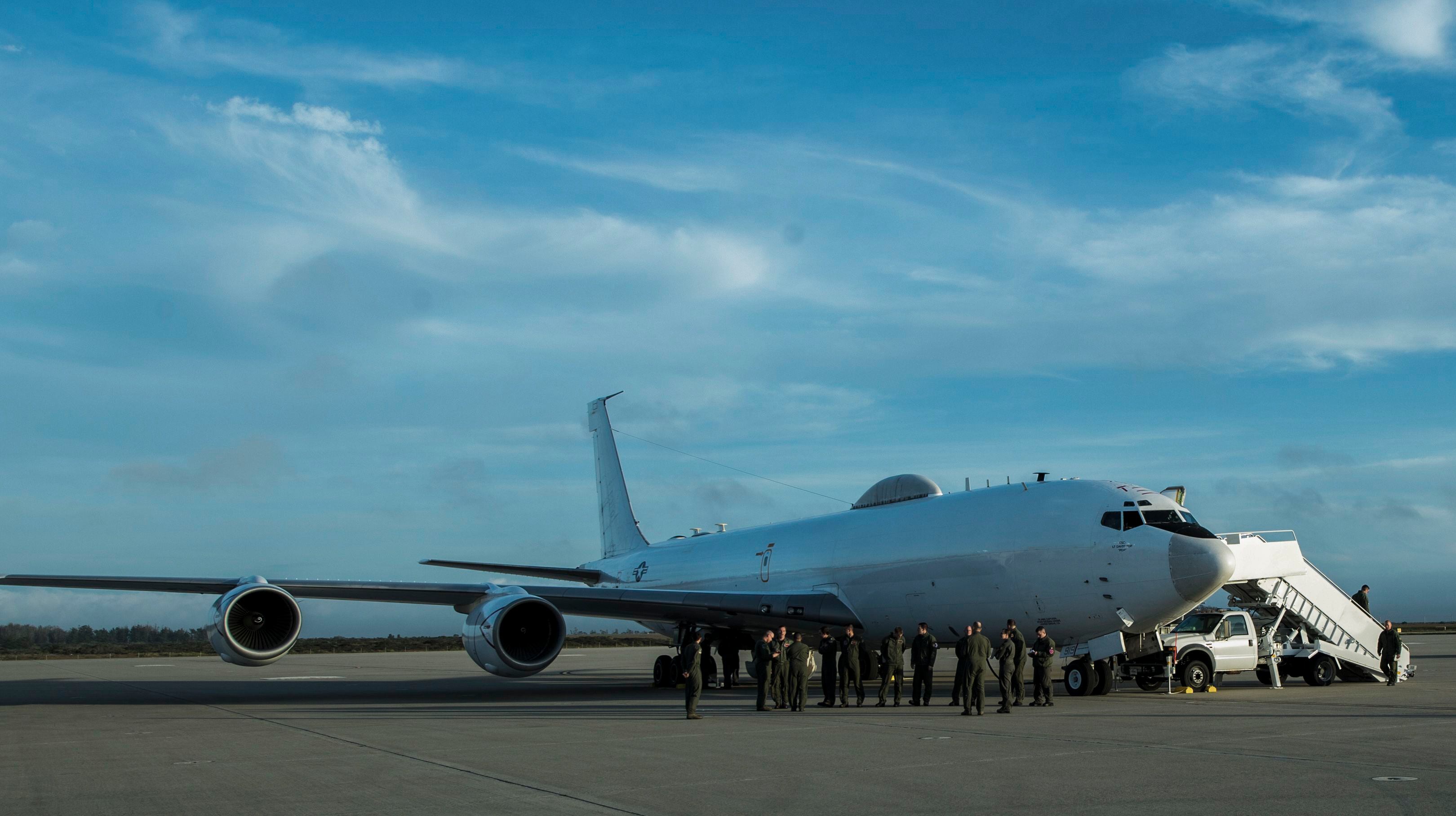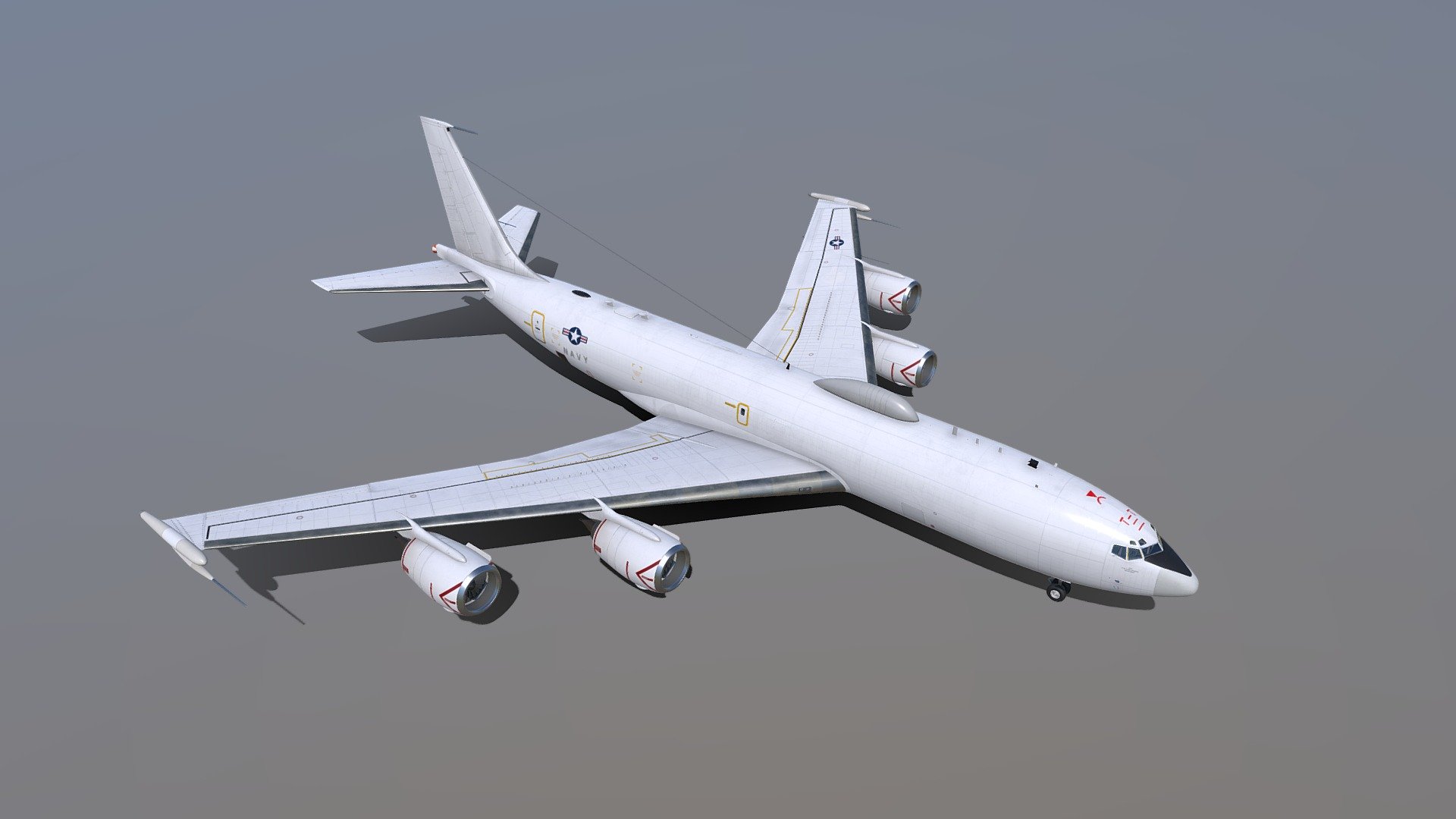Navy E6 Aircraft - The primary mission of the E-6 Mercury is to link the country's command authority with the US Navy's nuclear missile force carrying ballistic missile submarines at sea. The E-6 is the military version of the 707 commercial civilian aircraft and carries a very low frequency communication system with dual twin wire antennas.
The E-6B was developed as a replacement for the Air Force Command's aging EC-135 fleet. The E-6B modified the E-6A by adding combat personnel positions and other specialized equipment.
Navy E6 Aircraft

The E-6B is a dual-mission aircraft capable of performing either the E-6A mission or the air strategic command post mission and is equipped with an Air Launch Control System (ALCS). The ALCS is capable of launching US land-based intercontinental ballistic missiles. The first E-6B was delivered in December 1997 and the E-6B completed its dual operational mission in October 1998. The E-6 fleet was completely converted to the E-6B configuration in 2003.
Aviation Photographs Of Boeing E 6b Mercury
Boeing developed its commercial 707 E-6A to replace the aging EC-130Q in the Navy's TACAMO ("Charge and Move") mission. TACAMO links the NCA with the Navy's Ballistic Missile Team during a crisis.
Ukraine's military has used self-propelled artillery to push back Russian forces from the country's second-largest army...
Real-life Top Gun pilots take to the skies in F-35 fighter jets. This is considered the most...
The Ukrainian army uses American M777 howitzers on the battlefield in an attempt to repel Russian forces...
Usaf And Navy Could Team Up On E 6 Recap
Civilian and emergency crews responded to the crash of a Marine Corps plane in the Southern California desert on Wednesday…
Satellite images of Ukraine's Snake Island released Friday show a group of Russian ships sunk...
Future Destroyers Will Honor Vietnam War Heroes Navy Secretary Carlos Del Toro has announced that one of the service's new yet-to-be-built destroyers will be named...

The Navy may have to choose between weapons and aid to Ukraine, officials said, as ammunition delays hamper US aid to Ukraine.
United States Navy Boeing E 6b Mercury Of Strategic
Ukrainian troops train under Patriot system in Oklahoma Kiev's decision to withdraw its troops from the battlefield to train in the United States across the Atlantic Ocean is unusual.
Marines announce new uniform order amid shortages The Marine Corps is still facing shortages of uniforms, including the usual military blouses, but...
Canada completes deal to buy 88 US F-35 fighter jets The first four aircraft are at full capacity for the fleet, which is expected to be delivered in 2026... The E-6 Mercury has the capability to launch a nuclear war against Russia . or China at the behest of President Joe Biden – In a military that operates Raptor stealth fighters, A-10 tank boosters, B-52 bombers and Harrier jump jets, the quiet-looking E-6 Mercury, based on the US Navy's 707 aircraft, seems very not impressive. But don't be fooled by appearances. Although the Mercury carries no weapons of its own, it may be the most dangerous aircraft the Pentagon has ever operated, as it is tasked with directing the launch of land-based and sea-based nuclear ballistic missiles.
Of course, the U.S. military has a ground-based Strategic Global Operations Center in Nebraska and ground-based communications with the nuclear triad. However, the main purpose of the E-6 is to maintain communication links between the national command body (starting with the president and the secretary of defense) and the US nuclear forces, even if the ground command center is destroyed by the enemy's first strike. In other words, you can cut off the head of the US nuclear forces, but the body will come to you thanks to this doomsday plane.
Boeing E 6b Mercury (707 300)
The primary mission of the E-6 is called Charge and Move (TACAMO). Prior to the development of the E-6, TACAMO missions were performed by ground-based transmitters, and later by EC-130G and Q Hercules aircraft, which had ultra-low frequency radios for communications with Navy submarines. Interestingly, France also operated its own TACAMO aircraft until 2001, four modified Transall C-160H
The first of sixteen E-6s entered service between 1989 and 1992.
A long line of military variants of the venerable Boeing 707 aircraft, notably the 707-320B Advanced, are also used in the E-3 Sentry. The E-6A, with thirty-one communications antennas, was initially tasked with communicating with Navy submarines. Re-equipped with fuel-efficient CFM-56 turbojets and benefiting from expanded fuel tanks, the E-6A can stay in the air for up to fifteen hours or up to seventy-two hours.

To use the ultra-low frequency radio, the E-6 must fly in continuous orbit at high altitude, with the VLF radio mounted on the fuselage and its tail following a wire antenna one and five miles long at a vertical angle. relationship! Vlf signals from Ohio-class nuclear ballistic missile submarines lie thousands of miles underground. However, the limited bandwidth of VLF transmitters means they can only transmit raw data at thirty-five alphanumeric characters per second.
File:boeing E 6b Mercury, United States
Even slower than an old 14k internet modem from the 1990s. However, it is sufficient to send an emergency message directing the ship under the ballistic missile to carry out one of the various menus of nuclear attacks that have been planned from a limited to a full-scale nuclear attack. The E-6 system is also hardened to withstand the electromagnetic pulse of a nuclear weapon detonating below.
Between 1997 and 2006, the Pentagon upgraded its entire E-6A fleet to the dual-role E-6B, which expanded the Mercury's capabilities and allowed it to serve as an Air Friendly Nuclear Command Post. In this role, it serves as a backup to four large E-4 command post aircraft based on the 747 Jumbo jet. The E-6B has an ultra-high frequency radio in its air launch control system that allows it to remotely launch ground-based ballistic missiles from underground silos, a task previously assigned to the US Air Force's EC-135 Looking Glass aircraft - another. 707 options. The E-6 crew was expanded from fourteen to twenty-two for command post missions that usually included an admiral or general on board. An additional UHF radio gave the E-6B access to the surviving MILSTAR satellite communications network, and the cockpit was upgraded with new avionics and instruments from the 737NG aircraft. In the picture, the E-6B can be distinguished by the additional wing-equipped slots.
The E-6 Mercury's multi-communications equipment allows it to perform non-nuclear Command, Control and Communications (C3) operations. For this reason, E-6s are sometimes deployed to Europe and the Middle East to serve as C3 flight centers. For example, VQ-4 was deployed to Qatar for three years from 2006 to 2009, where it relayed information such as Daesh bombing reports and unrelated medical evacuation requests to US military headquarters in Iraq.
Two Navy aerial reconnaissance squadrons currently operate the E-6: VQ-3 "Ironmen" and VQ-4 "Shadows", both under Naval Strategic Communications Wing 1. They are based at Tinker Air Force Base in Oklahoma, but also regular forward deployments from Travis AFB in California and Patuxent River Air Force Station in Maryland. Always keep at least one E-6 in the air. E-6s on submarine communications missions often fly in circles over the ocean at low speeds—up to ten hours at a time. Those who run nuclear command post missions are usually on guard near Offutt Air Force Base in Nebraska. The E-6's nuclear mission has also made its operations fodder for conspiracy theorists and foreign propaganda outlets.
U.s. Navy's E 6b “doomsday Aircraft” Flights Alert Major Powers
Mercury's E-6 platform should last until 2040 thanks to a service life extension program and regular changes to its systems and radios. Although Mercury has demonstrated its usefulness as an air communications hub to support troops in the field, the air command post is considered a success if it never fulfills its primary mission. The essence of a nuclear deterrent, however, is convincing a potential adversary that no first strike will be sufficient to prevent a damaging riposte. E-6 is an important component in making this threat credible.
Sebastian Roblin holds a master's degree in conflict resolution from Georgetown University and serves as a university lecturer in the Peace Corps in China.
Sebastian Roblin writes about the technical, historical, and political aspects of international security and conflict for The National Interest, NBC News, Forbes.com, and War Is Not an Interest. He earned a master's degree from Georgetown University and served in the Peace Corps in China. Bottom line: The E-6 platform should remain in service until 2040 thanks to a maintenance life extension program and regular upgrades to its systems and radios.

In a military that operates Raptor stealth fighters, A-10 tanks, B-52 bombers and Harrier jump jets, the E-6 Mercury, based on the US Navy's 707 aircraft, appears to be extremely weatherproof. But don't be fooled by appearances. Although the Mercury carries no weapons of its own, it may be the most dangerous aircraft the Pentagon has ever operated, as it is tasked with directing the launch of land-based and sea-based nuclear ballistic missiles.
Us Navy E 6b Mercury Images, Stock Photos & Vectors
Of course, the United States
Sig p365 tulster holster, sig p365 iwb holster, sig holsters p365, sig p365 sas holster, sig p365 xl holster, sig p365 hybrid holster, appendix holster sig p365, safariland holster sig p365, sig p365 belt holster, sig p365 holster, sig p365 purse holster, sig sauer p365 holster
0 Comments